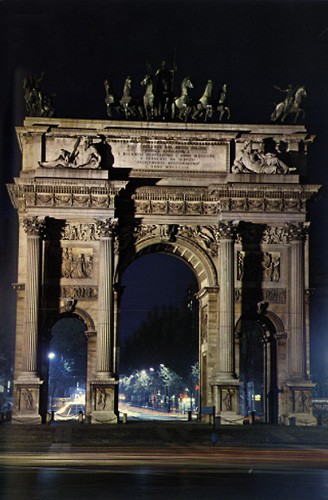When Napoleon named Milan the capital of the Cisalpine Republic on June 1st, 1797, he changed the city's destiny. In 1802 it became capital of the Italian Republic and then in 1805 capital of the Kingdom of Italy, firmly establishing its economic, political and administrative pre-eminence during the Napoleonic period. Furthermore, as a result of Milan's situation on the main transalpine routes of communication, namely the Simplon and the St Gothard passes, it had considerable strategic value and so was very quickly the object of urban development, encouraged by Bonaparte himself. Milan's facelift gave what remained of the medieval city a modern look, much more in keeping with its status of capital city.
On 23rd June, 1800 Napoleon ordered the destruction of the fortifications surrounding the central part of Milan's Castello Sforzesco so as to open up a vast area to be used for patriotic celebrations. On 20th June, 1801 this space was renamed Foro Buonaparte and the architect Giovanni Antonio Antolini was called in to oversee the redevelopment. The project was to make the Foro Buonaparte (with its antique name and style of architecture) into the political and economic centre of Milan. And even though because of the exorbitant cost it never got further than the foundation stone (laid on 30th April 1801 on the occasion of the signing of the Peace of Lunéville), Antolini's design nevertheless caused Milan's business centre to move further northeast as a result of the building of the main arterial road, the Corso Sempione, desired by Napoleon mainly for strategic reasons. The neighbourhood which grew up around, with municipal financial encouragement, was rationally planned and modern.
Other structures were subsequently erected at the Foro Buonaparte, notably, the present-day Parco Sempione (1805) and the arena (1807), both built by the architect Canonica. The arena (in the north-western corner of the park) could hold 30 000 spectators and many festivals, military parades, even chariot races and mock sea battles were held there during the first half of the 19th century.
The other most notable building in the Foro Buonaparte (designed by Cagnola, with work beginning in 1807), was the triumphal arch known today as the Arco della Pace (arch of peace) or the Arco Sempione. Built to frame the end of the Corso Sempione in line with the Castello Sforzesco, the Arco della Pace is considered as the finest example of Lombard Neo-Classicism. As to its design, it repeats the canvas and wooden arch erected for the wedding celebrations of Eugene de Beauharnais, the viceroy of Italy, to Amelia of Bavaria.
The monument itself is composed of three arches punctuated by detached Corinthian columns on pedestals and surmounted by a monumental upper storey capped with an allegory of Peace driving a chariot pulled by six horses. In place of an olive branch Peace originally carried a sword symbolising the Napoleonic victories in Italy. But with the arch still unfinished at the fall of the First Empire, it was the Austrian Emperor who oversaw the completion and who altered the symbolism.
Although first designed to glorify Napoleon, the arch in the Foro Buonaparte was given the name Arco della Pace in celebration of the European-wide peace of 1815. In the same way, whilst the allegories of the Italian rivers, the Po, the Ticino, the Tagliamento and the Adige, crowning the entablatures were not altered, the bas-reliefs between the columns – with their Napoleonic themes – were re-carved and transformed into antique scenes. The inscription in Italian (added at a later date) reads “The Milanese built this arch in 1807 in honour of the Kingdom of Italy, founded under Napoleon I, and set free from the yoke of slavery they restored it with gratitude in 1859”. For it was in 1859 that this monument played a part in the festivities when Napoleon III and Vittorio Emmanuele II made their triumphal entry into Milan passing underneath it in celebration of the national victory at Magenta.
Foro Buonaparte


